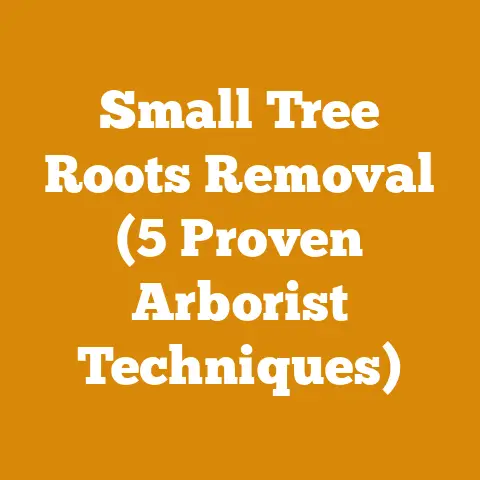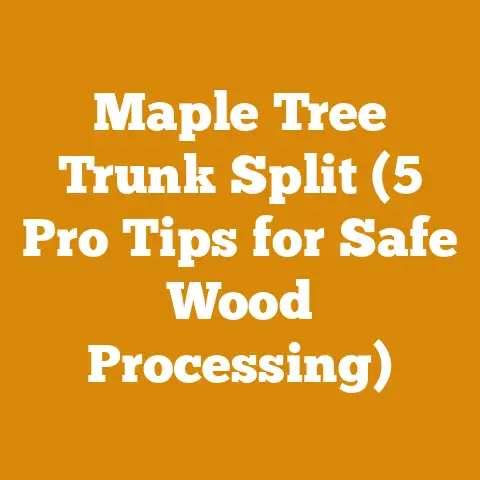Kill Poison Ivy on Tree (Expert Chainsaw & Removal Tips)
Killing Poison Ivy on Trees: An Expert Guide to Chainsaw Use and Removal
Dealing with poison ivy clinging to trees is a common challenge, especially when working in forested areas. It’s a task that demands caution, precision, and the right tools. Here’s a detailed guide to safely and effectively removing poison ivy from trees, including essential chainsaw techniques and preventative measures.
1. Understanding the Threat: Why Poison Ivy Removal Matters
Poison ivy ( Toxicodendron radicans ) poses a significant health risk due to urushiol, an oil that causes allergic reactions upon skin contact. When clearing land for logging, firewood harvesting, or any other wood processing activity, encountering poison ivy is almost inevitable. Leaving it unchecked can lead to:
- Health hazards for workers: Increased medical costs and lost productivity due to allergic reactions.
- Spread to other areas: Poison ivy can quickly propagate, affecting larger areas and increasing the risk of exposure.
- Equipment contamination: Urushiol can contaminate tools and clothing, leading to secondary exposure.
Therefore, effective poison ivy removal is not just about aesthetics; it’s about safety, efficiency, and responsible land management.
2. Safety First: Essential Protective Gear and Precautions
Before even thinking about firing up a chainsaw, prioritize safety. Urushiol is incredibly persistent, so thorough protection is paramount. Here’s what I recommend:
- Full-coverage clothing: Long sleeves, long pants, and a hat are essential. I prefer disposable coveralls for heavily infested areas.
- Gloves: Wear thick, durable gloves, preferably nitrile or vinyl, not latex. Disposable gloves are ideal to avoid contamination.
- Eye protection: Safety glasses or a face shield are crucial to protect your eyes from sap and debris.
- Respirator (optional): If burning poison ivy (which I strongly advise against unless you have the right equipment and conditions), a respirator is necessary to avoid inhaling urushiol-laden smoke.
- Barrier cream: Apply a barrier cream containing bentoquatam (e.g., IvyBlock) to exposed skin. This can help prevent urushiol from penetrating the skin.
- Post-exposure wash: Keep a bottle of Tecnu or dish soap readily available. Wash exposed skin thoroughly with cold water and soap as soon as possible after potential contact. Hot water can open pores and worsen the reaction.
- Designated laundry: Wash contaminated clothing separately and immediately. Run your washing machine empty with hot water and detergent afterward to clean it.
- Tool cleaning: Wipe down tools with rubbing alcohol or a degreaser to remove urushiol.
My Personal Experience: I learned the hard way about the importance of thorough cleaning. After a particularly nasty encounter with poison ivy during a logging project, I developed a severe rash despite wearing gloves. It turned out the urushiol had seeped into the seams of my gloves. Now, I always use disposable gloves and thoroughly clean my reusable gloves after each use.
3. Identifying Poison Ivy: Knowing Your Enemy
Accurate identification is crucial. Poison ivy typically has:
- “Leaves of three, let it be”: Three leaflets arranged on a single stem.
- Alternate leaf arrangement: The leaves grow in an alternating pattern along the stem.
- Varied leaf shape: Leaflets can be smooth, toothed, or lobed.
- Hairy vines: Mature poison ivy vines are often thick and hairy, clinging tightly to trees.
- White berries: In late summer and fall, poison ivy produces clusters of small, white berries.
Distinguishing from Similar Plants: Virginia creeper also has leaflets, but it usually has five, not three. Boxelder maple saplings can sometimes resemble poison ivy, but their leaves are arranged oppositely on the stem.
4. Choosing the Right Removal Method: Chainsaw vs. Other Options
Several methods exist for removing poison ivy, each with its pros and cons:
- Manual removal: Pulling the vines by hand (with proper protection) can be effective for small infestations, but it’s labor-intensive and increases the risk of exposure.
- Herbicide application: Herbicides containing glyphosate or triclopyr can kill poison ivy, but they can also harm non-target plants. Use caution and follow label instructions carefully. I avoid this method if possible, especially near waterways or sensitive areas.
- Cutting the vine: This is where the chainsaw comes in. Cutting the vine at the base prevents it from sending nutrients to the upper parts of the plant, eventually killing the foliage.
Why Chainsaw Use is Appropriate: A chainsaw is particularly useful for:
- Thick, mature vines: These are often too difficult to cut with hand tools.
- Large-scale infestations: Chainsaws can quickly clear large areas of poison ivy.
- Accessing hard-to-reach areas: A chainsaw with a long bar can reach vines high up in trees.
However, chainsaw use also presents risks:
- Increased risk of urushiol exposure: Cutting the vine can release sap, increasing the chance of skin contact.
- Kickback and other chainsaw hazards: Chainsaw operation requires proper training and safety precautions.
- Damage to the tree: Careless cutting can injure the tree’s bark or cambium layer.
5. Chainsaw Techniques for Poison Ivy Removal: A Step-by-Step Guide
Here’s my method for safely and effectively removing poison ivy with a chainsaw:
- Prepare the area: Clear away any brush or debris around the base of the tree to provide a safe working space.
- Identify the main vine: Locate the thickest vine(s) growing up the tree. These are the primary source of nutrients for the poison ivy.
- Make the first cut: Carefully cut the vine as close to the ground as possible. Use a sharp chainsaw and maintain a steady grip. Avoid cutting into the tree’s bark.
- Make a second cut: Cut the vine again about 6-12 inches above the first cut. This removes a section of the vine and prevents it from re-sprouting.
- Dispose of the cut sections: Carefully place the cut sections of the vine in a heavy-duty trash bag for disposal. Do not burn poison ivy unless you have the proper equipment and conditions, as the smoke can cause severe respiratory irritation.
- Monitor for re-growth: Check the area regularly for new growth. If any new shoots appear, cut them off or apply herbicide as needed.
Pro Tip: I often use a pruning saw or loppers for smaller vines and a chainsaw only for the thickest, most established ones. This minimizes the risk of kickback and reduces the amount of urushiol released.
6. Post-Removal Treatment: Preventing Re-infestation
Simply cutting the vine is not enough. You need to prevent it from re-sprouting. Here are some options:
- Apply herbicide to the cut stump: Immediately after cutting the vine, apply a herbicide containing glyphosate or triclopyr to the cut surface. This will help kill the roots and prevent re-growth.
- Mulch the area: Cover the area around the base of the tree with a thick layer of mulch to suppress new growth.
- Monitor and repeat: Regularly inspect the area for new shoots. Repeat the cutting and herbicide application as needed.
My preferred method: I often combine cutting with a targeted application of a systemic herbicide. This provides the most effective long-term control.
7. Chainsaw Maintenance: Keeping Your Saw Sharp and Safe
A sharp chainsaw is essential for safe and efficient poison ivy removal. Here are some tips for chainsaw maintenance:
- Sharpen the chain regularly: A dull chain requires more force and increases the risk of kickback.
- Check the chain tension: A loose chain can derail and cause injury.
- Clean the air filter: A dirty air filter can reduce engine performance and increase fuel consumption.
- Lubricate the chain: Proper lubrication prevents the chain from overheating and wearing out prematurely.
- Inspect the saw for damage: Check for loose parts, cracks, or other damage before each use.
Remember: Always follow the manufacturer’s instructions for chainsaw maintenance and operation.
8. Alternative Removal Methods: When Chainsaw is Not the Best Option
While chainsaws are effective for many poison ivy removal tasks, there are situations where other methods are more appropriate:
- Small infestations: For small patches of poison ivy, manual removal or herbicide application may be sufficient.
- Sensitive areas: Near waterways or sensitive plants, herbicide use should be avoided. Manual removal or cutting the vine without herbicide application may be the best option.
- High up in trees: Removing poison ivy high up in trees can be dangerous. Consider hiring a professional arborist.
My experience: I once tried to remove poison ivy from a very tall tree using a ladder and a chainsaw. It was a mistake. The risk of falling was too high. I ended up hiring a professional arborist who used specialized equipment to safely remove the vine.
9. Legal Considerations: Permits and Regulations
Before starting any poison ivy removal project, check with your local authorities to see if any permits or regulations apply. Some areas may restrict herbicide use or require permits for tree removal.
Be a good neighbor: Inform your neighbors of your plans, especially if the poison ivy is growing near property lines.
10. Project Metrics for Poison Ivy Removal: Measuring Success
Even a seemingly simple task like poison ivy removal can benefit from tracking key metrics. This helps you optimize your approach and improve efficiency.
- Time spent per tree: Track the time it takes to remove poison ivy from each tree. This can help you estimate the time required for future projects.
- Herbicide usage: Monitor the amount of herbicide used per tree. This can help you optimize herbicide application and reduce costs.
- Re-growth rate: Track the rate of re-growth after removal. This can help you evaluate the effectiveness of your removal method and adjust your approach accordingly.
- Incidence of skin reactions: Monitor the number of workers who develop skin reactions to poison ivy. This can help you identify areas where safety precautions need to be improved.
- Cost per tree: Calculate the total cost of removing poison ivy from each tree, including labor, materials, and equipment. This can help you determine the most cost-effective removal method.
By tracking these metrics, you can gain valuable insights into your poison ivy removal process and make data-driven decisions to improve efficiency, safety, and cost-effectiveness.
Why Track Project Metrics?
Tracking project metrics isn’t just about crunching numbers; it’s about gaining a deeper understanding of your operations, identifying areas for improvement, and making informed decisions that drive profitability. By monitoring key performance indicators (KPIs), I can:
- Optimize efficiency: Identify bottlenecks and streamline processes.
- Reduce waste: Minimize wood loss and improve resource utilization.
- Enhance product quality: Ensure consistent firewood size, moisture content, and cleanliness.
- Control costs: Track expenses and identify opportunities for savings.
- Improve safety: Monitor safety incidents and implement preventative measures.
- Make data-driven decisions: Base my decisions on concrete data rather than guesswork.
My Story: I remember a time when I was running a small firewood business without tracking any metrics. I was working long hours, but my profits were minimal. It wasn’t until I started tracking my production time, wood waste, and customer satisfaction that I realized where I was going wrong. By identifying and addressing these issues, I was able to significantly increase my efficiency and profitability.
Key Project Metrics to Track:
Here are the key project metrics I focus on, broken down for clarity and actionable insights:
-
Production Time per Cord (or Unit):
- Definition: The amount of time it takes to produce one cord (or other unit of measurement) of firewood, lumber, or other processed wood product.
- Why it’s important: This metric directly impacts labor costs and overall production capacity. It helps identify inefficiencies in your process.
- How to interpret it: A high production time per cord indicates potential bottlenecks in your workflow. A low production time per cord suggests an efficient process.
- How it relates to other metrics: It’s closely related to equipment downtime, worker productivity, and wood volume yield. If equipment downtime is high, production time per cord will also be high.
- Example: If it takes 8 hours to produce one cord of firewood, your production time per cord is 8 hours.
- Actionable Insight: If I notice my production time per cord is increasing, I investigate the cause. Is my equipment running efficiently? Are my workers properly trained? Are there any bottlenecks in my workflow?
- Data Point: In my firewood business, I aim for a production time of 4-6 hours per cord. If it exceeds 6 hours, I know something needs to be addressed.
-
Wood Volume Yield Efficiency:
- Definition: The percentage of usable wood obtained from a given volume of raw logs.
- Why it’s important: This metric measures how effectively you’re utilizing your raw materials. High yield efficiency translates to lower material costs and increased profitability.
- How to interpret it: A low yield efficiency indicates excessive wood waste, which could be due to poor cutting techniques, improper log handling, or inefficient processing equipment.
- How it relates to other metrics: It’s directly related to wood waste percentage and log cost per cord. If wood waste is high, yield efficiency will be low.
- Example: If you process 10 cords of raw logs and obtain 8 cords of usable firewood, your yield efficiency is 80%.
- Actionable Insight: I meticulously track my wood volume yield efficiency to identify areas where I can reduce waste. Are my sawmills cutting efficiently? Am I properly utilizing smaller pieces of wood for kindling or other products?
- Data Point: I strive for a wood volume yield efficiency of 85% or higher in my firewood operation.
-
Wood Waste Percentage:
- Definition: The percentage of raw wood material that is discarded or unusable after processing.
- Why it’s important: High wood waste translates to lost revenue and increased disposal costs. Minimizing wood waste is crucial for both profitability and environmental sustainability.
- How to interpret it: A high wood waste percentage indicates inefficiencies in your processing methods or poor utilization of raw materials.
- How it relates to other metrics: It’s the inverse of wood volume yield efficiency. If wood waste is high, yield efficiency will be low.
- Example: If you process 10 cords of raw logs and generate 2 cords of wood waste, your wood waste percentage is 20%.
- Actionable Insight: I analyze my wood waste to identify the sources of loss. Is it due to bark, sawdust, or unusable pieces? Can I repurpose the waste for other uses, such as mulch or compost?
- Data Point: I aim to keep my wood waste percentage below 15% in my firewood business.
-
Equipment Downtime:
- Definition: The amount of time that equipment is out of service due to maintenance, repairs, or breakdowns.
- Why it’s important: Equipment downtime directly impacts production capacity and increases operating costs. Minimizing downtime is crucial for maintaining consistent output.
- How to interpret it: High equipment downtime indicates potential issues with equipment maintenance, reliability, or operator training.
- How it relates to other metrics: It’s closely related to production time per cord and maintenance costs. If equipment downtime is high, production time per cord will also be high, and maintenance costs will increase.
- Example: If a chainsaw is out of service for 2 hours per day due to maintenance or repairs, its downtime is 2 hours.
- Actionable Insight: I meticulously track equipment downtime to identify recurring issues. Do I need to invest in more reliable equipment? Am I performing preventative maintenance regularly?
- Data Point: I aim to keep equipment downtime below 5% of total operating time in my firewood operation.
-
Moisture Content Levels:
- Definition: The percentage of water content in firewood or lumber.
- Why it’s important: Moisture content significantly affects the burning efficiency of firewood and the structural integrity of lumber. Proper moisture content is crucial for product quality and customer satisfaction.
- How to interpret it: High moisture content indicates that the wood is not properly seasoned or dried. Low moisture content indicates that the wood is properly seasoned or kiln-dried.
- How it relates to other metrics: It’s directly related to drying time and customer satisfaction. If moisture content is high, firewood will burn poorly, and customers will be dissatisfied.
- Example: Firewood with a moisture content of 20% or less is considered properly seasoned.
- Actionable Insight: I regularly monitor the moisture content of my firewood to ensure it meets my quality standards. Do I need to improve my seasoning process? Am I storing the firewood properly?
- Data Point: I aim for a moisture content of 15-20% in my firewood.
-
Drying Time (for Firewood):
- Definition: The amount of time it takes for firewood to reach the desired moisture content level.
- Why it’s important: This metric helps you plan your production schedule and ensure that you have a sufficient supply of seasoned firewood.
- How to interpret it: A long drying time indicates that your seasoning process is inefficient. A short drying time suggests an efficient seasoning process.
- How it relates to other metrics: It’s directly related to moisture content levels and customer satisfaction. If drying time is long, moisture content will be high, and customers will be dissatisfied.
- Example: It typically takes 6-12 months for firewood to properly season in my climate.
- Actionable Insight: I experiment with different seasoning methods to reduce drying time. Am I stacking the firewood properly to maximize airflow? Am I using a covered storage area to protect it from rain?
- Data Point: I aim to reduce my firewood drying time to 6 months or less.
-
Cost per Cord (or Unit):
- Definition: The total cost of producing one cord (or other unit of measurement) of firewood, lumber, or other processed wood product.
- Why it’s important: This metric directly impacts profitability. It helps you identify areas where you can reduce costs and increase your profit margin.
- How to interpret it: A high cost per cord indicates inefficiencies in your production process or high input costs. A low cost per cord suggests an efficient process and low input costs.
- How it relates to other metrics: It’s related to all other metrics, including production time per cord, wood volume yield efficiency, equipment downtime, and labor costs.
- Example: If it costs $100 to produce one cord of firewood, your cost per cord is $100.
- Actionable Insight: I meticulously track all my expenses to calculate my cost per cord. Am I paying too much for raw logs? Can I reduce my labor costs? Am I wasting materials?
- Data Point: I aim to keep my cost per cord below $80 in my firewood business.
-
Labor Costs:
- Definition: The total cost of labor associated with wood processing or firewood preparation.
- Why it’s important: Labor is often a significant expense in the wood industry. Tracking labor costs helps you optimize staffing levels and improve worker productivity.
- How to interpret it: High labor costs indicate potential inefficiencies in your workflow or overstaffing. Low labor costs suggest an efficient workflow and appropriate staffing levels.
- How it relates to other metrics: It’s closely related to production time per cord and worker productivity. If production time per cord is high, labor costs will also be high.
- Example: If you pay your workers $20 per hour and they work 40 hours per week, your labor costs are $800 per week.
- Actionable Insight: I regularly evaluate my staffing levels and workflow to optimize labor costs. Am I using the right tools and equipment to maximize worker productivity? Am I providing adequate training to my workers?
- Data Point: I aim to keep my labor costs below 30% of my total revenue in my firewood business.
-
Fuel Consumption:
- Definition: The amount of fuel consumed by equipment used in wood processing or firewood preparation.
- Why it’s important: Fuel is a significant operating expense. Tracking fuel consumption helps you identify opportunities to reduce fuel costs and improve energy efficiency.
- How to interpret it: High fuel consumption indicates that your equipment is not running efficiently or that you are using outdated equipment. Low fuel consumption suggests efficient equipment and optimized operating practices.
- How it relates to other metrics: It’s closely related to equipment downtime and production time per cord. If equipment downtime is high, fuel consumption will also be high.
- Example: If a chainsaw consumes 1 gallon of fuel per hour, its fuel consumption is 1 gallon per hour.
- Actionable Insight: I regularly maintain my equipment to ensure it is running efficiently. Am I using the right type of fuel for my equipment? Am I avoiding unnecessary idling?
- Data Point: I track the fuel consumption of each piece of equipment in my firewood operation and look for ways to reduce it.
-
Customer Satisfaction:**
- Definition: A measure of how satisfied customers are with your products and services.
- Why it’s important: Customer satisfaction is crucial for building a loyal customer base and generating repeat business.
- How to interpret it: High customer satisfaction indicates that your products and services are meeting or exceeding customer expectations. Low customer satisfaction suggests that you need to improve your products or services.
- How it relates to other metrics: It’s directly related to product quality, moisture content levels, and delivery time. If product quality is high and moisture content is low, customers will be satisfied.
- Example: You can measure customer satisfaction by conducting surveys, collecting feedback, or monitoring online reviews.
- Actionable Insight: I actively solicit feedback from my customers and use it to improve my products and services. Am I delivering firewood on time? Is the firewood properly seasoned? Am I providing excellent customer service?
- Data Point: I aim for a customer satisfaction rating of 90% or higher in my firewood business.
Case Studies: Real-World Applications
Let’s look at a few case studies to illustrate how these metrics can be applied in real-world scenarios:
Case Study 1: Optimizing Firewood Production
- Challenge: A small firewood business was struggling to meet demand due to low production efficiency.
- Metrics Tracked: Production time per cord, wood volume yield efficiency, equipment downtime.
- Findings: Production time per cord was high due to inefficient splitting equipment and poor workflow. Wood volume yield efficiency was low due to excessive waste. Equipment downtime was frequent due to lack of preventative maintenance.
- Solutions: The business invested in a new hydraulic splitter, optimized its workflow, and implemented a preventative maintenance program.
- Results: Production time per cord decreased by 30%, wood volume yield efficiency increased by 15%, and equipment downtime decreased by 50%. The business was able to meet demand and increase its profitability.
Case Study 2: Reducing Wood Waste in a Logging Operation
- Challenge: A logging operation was generating a significant amount of wood waste due to poor cutting practices and inefficient log handling.
- Metrics Tracked: Wood waste percentage, log cost per cord, fuel consumption.
- Findings: Wood waste percentage was high due to improper bucking techniques and damage to logs during skidding. Log cost per cord was high due to the amount of waste. Fuel consumption was high due to inefficient skidding practices.
- Solutions: The logging operation provided training to its workers on proper bucking techniques, improved log handling practices, and optimized skidding routes.
- Results: Wood waste percentage decreased by 20%, log cost per cord decreased by 10%, and fuel consumption decreased by 15%. They may lack the resources, time, or expertise to implement sophisticated tracking systems. However, even simple tracking methods can provide valuable insights. Here are some tips for overcoming these challenges:
- Start small: Don’t try to track everything at once. Focus on the metrics that are most important to your business.
- Use simple tools: You don’t need expensive software or equipment to track project metrics. A spreadsheet or notebook can be just as effective.
- Involve your workers: Get your workers involved in the tracking process. They can provide valuable insights and help you identify areas for improvement.
- Make it a habit: Make tracking project metrics a regular part of your routine. The more consistently you track your metrics, the more valuable the data will be.
Applying These Metrics to Improve Future Projects
The ultimate goal of tracking project metrics is to improve future wood processing or firewood preparation projects. By analyzing the data you collect, you can identify areas where you can:
- Increase efficiency: Streamline your workflow, optimize equipment usage, and improve worker productivity.
- Reduce waste: Minimize wood loss, repurpose waste materials, and improve resource utilization.
- Enhance product quality: Ensure consistent firewood size, moisture content, and cleanliness.
- Control costs: Track expenses, identify opportunities for savings, and negotiate better prices with suppliers.
- Improve safety: Monitor safety incidents, implement preventative measures, and provide safety training to your workers.
By consistently tracking and analyzing project metrics, you can transform your wood processing or firewood preparation operation into a well-oiled machine that delivers consistent results and maximizes profitability. Remember, knowledge is power, and data is the key to unlocking that power in the wood industry.






